
I am squarely in the dysfunctional shoulder camp. In my last post, Create Rotator Cuff Stability To Improve Shoulder Agility, I wrote about rotator cuff risk factors for injury and recovery. My shoulder issues began after I partially dislocated my right shoulder at age seven and I’ve since had chronic issues associated with both lax ligaments and muscle tightness. My left shoulder has been a problem child since I fell off of a moped in Key West about 15 years ago and had to immobilize my left arm in a sling for six weeks. Now I know that muscle strength can decrease up to 17 percent within 72 hours of immobilizing a joint and that you can lose up to 40 percent (!) of muscle strength in six weeks. While yoga and other practices helped ease my shoulder pain following the accident, it really was my introduction to Yoga Tune Up®’s Roll Model Therapy Balls in 2011 that slowly but surely began helping me to comb through and unwind those angry tissues, each time a little bit better than before.
YTU prioritizes functional movement and emphasizes self-care as healthcare. For me, the rotator cuff Roll Model sequence (pp. 292-302) opened my eyes to how much tension I had allowed to accumulate in my shoulders. I realized that it’s imperative to wake up these muscle fibers and connective tissues and deal with potential trigger points that may impede muscle function and thus joint function!
As noted, since shoulder abduction and external rotation weakness are risk factors for developing rotator cuff problems, this is a great place to work with preventing injury in the first place. Here is my dream-team rotator cuff exercise practice that is fun, efficient in time, economical in moves and takes your shoulder joint through dynamic and static strengthening and stretching:
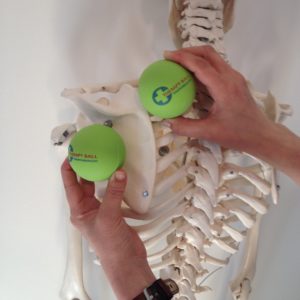
-Rotator cuff roll-out from The Roll Model by Jill Miller
-Scapula spelunking at the wall, placing one ball in the infraspinatus and one at the superior angle of the scapula (Figure 3)
–Piano Fingers (from the Upper Body Quick Fix Rx DVD)
–Hitchhiking pizzas
-Matador circles
-Pranic bath
Because the shoulder is so mobile and we don’t walk on our hands, it can tolerate a bit more abuse than the feet, knees, or hips. But the shoulder girdle still bears weight and helps us support our heads, carry our loads, and perform many, many movements associated with living a “normal” life. Rebalance and strengthen your rotator cuff to keep your shoulders stable within their mobility!
References
- Colvin, A.C., Egorova, N., Harrison, A.K., Moskowitz, A., & Flatow, E.L. (2012). National trends in rotator cuff repair. Journal of Bone and Joint Surgery 94:227–233. Retrieved from http://www.ncbi.nlm.nih.gov/pmc/articles/PMC3262185/
- Cook, G., & Jones, B. (2006). Secrets of the Shoulder [DVD]. Functional Movement.
- David, G., Magarey, M.E., Jones, M.A., Dvir, Z. Türker, K.S., & Sharpe, M. (2000). EMG and strength correlates of selected shoulder muscles during rotations of the glenohumeral joint. Clinical Biomechanics 15(2):95–102.
- Davies, C. (2006). The frozen shoulder workbook. Oakland, CA: New Harbinger Publications.
- Gladstone, J.N., Bishop, J.Y., Lo, I.K., & Flatow, E.L. (2007). Fatty infiltration and atrophy of the rotator cuff do not improve after rotator cuff repair and correlate with poor functional outcome [Abstract]. American Journal of Sports Medicine 35(5):719–728. Retrieved from http://www.ncbi.nlm.nih.gov/pubmed/17337727
- Johnson, J. (2006). Treat your own rotator cuff. Indianapolis, IN: Dog Ear Publishing.
- Knopf, K. (2010). Healthy shoulder handbook. Berkeley, CA: Ulysses Press.
- Miller, J. (2014). The roll model: A step-by-step guide to erase pain, improve mobility, and live better in your body. Las Vegas: Victory Belt.
- Muscolino, J. (2011). Kinesiology: The skeletal system and muscle function (2nd ed.). St. Louis, MO: Elsevier.
- Osti, L., Buda, M., & Del Buono, A. (2013). Fatty infiltration of the shoulder: Diagnosis and reversibility. Muscles, Ligaments, and Tendons Journal 3(4): 351-354. Retrieved from http://www.mltj.org/materiale_cic/724_3_4/6265_fatty/article.htm
- Peat, M. (1986). Functional anatomy of the shoulder complex. Physical Therapy 66, 1855–1865. Retrieved from http://ptjournal.apta.org/content/66/12/1855
- Wendelboe, A.M., Hegmann, K.T., Gren, L.H., Alder, S.C., White, G.L., & Lyon, J.L. (2004). Associations between body-mass index and surgery for rotator cuff tendinitis. Journal of Bone and Joint Surgery 86(4):743-747.
- Yamaguchi, K. (2011, January). New guideline on rotator cuff problems. AAOS Now. American Association of Orthopaedic Surgeons. Retrieved from http://www.aaos.org/news/aaosnow/jan11/cover1.asp
- Yamamoto, A., Takagishi, K., Osawa, T., Yanagawa, T., Nakalima, D., Shitara, H., & Kobayashi, T. (2010). Prevalence and risk factors of a rotator cuff tear in the general population [Abstract]. Journal of Shoulder and Elbow Surgery 19(1):116–120. doi:10.1016/j.jse.2009.04.006
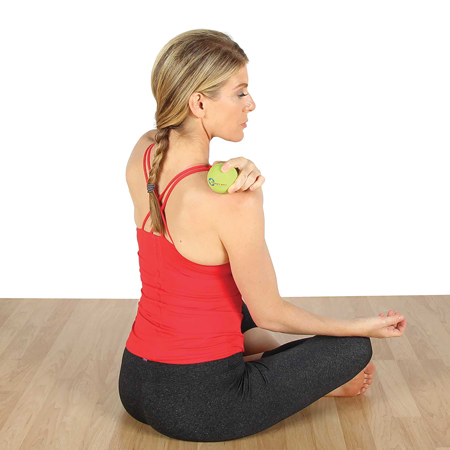



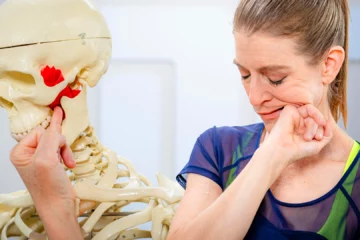
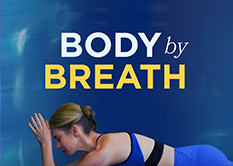



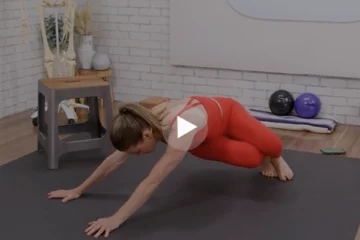
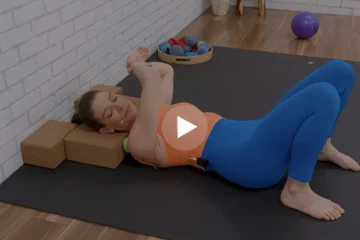


I like your comparison of the shoulders with the lower body joints. It helps to put things into perspective.
Dawn, Great combination of moves. Thanks for hooking me in with the personal story to start too.
Thanks for sharing your dream team rotator cuff practice. I appreciate your concise explanation of why this is important and how we can help our selves and our students prevent future shoulder injuries.
Thank you, Dawn! I have struggled with rotator cuff strength and mobility, and YTU has helped me rebalance it all. It is always a work in progress. Thank you for the dream-team rotator cuff practise! I look forward to giving it a try.
Thank you for the practice suggestions. I’m going to think about ways to focus more on abduction and external rotation!
Thanks for the suggested exercises. Just did the piano fingers and hitchhiking pizza before typing this comment, which are so great for a break at the computer. They even help my back as they bring more mindfulness to my spinal alignment. After having learned matador circles and pranic bath at YTU level 1, they have become staples in my self practice and my classes. Of course, rolling is so so addictive as it just feels great. Will suggest all these to my partner with a gambit of shoulder issues.
It is truly amazing that a person can walk around with so much tension in their body and not even be aware of it. I know that before I ever rolled on YTU therapy balls I had NO IDEA how stiff my tissues were – especially in my upper back and shoulders. I must have been walking around with my shoulders up around my ears without realizing it! Since I have been using my YTU balls I have definitely experienced more mobility in my upper back and shoulders – but there are a few exercises mentioned here I have yet to try out , so I’m excited to give them a try. I love incorporating the pranic bath exercise into my yoga sequences to heat up the shoulder joint before moving into any poses that require a lot of stability from the shoulder joint. Thanks!
Isn’t it amazing how we can get stuck in a rut and not realize how much we are missing out on from our lack of mobility until we get it back? YTU is like that last nose blow after having a stuffy nose for weeks and then suddenly you can breathe again!
This is great information, I also struggle with my right shoulder for years now, I just learned in the YTU about being mindful of external rotation when raising the arms. Thank you!
Thank you so much for this sequence, Dawn! I’ve been dealing with issues with my right shoulder for months and will definitely put this one into practice. The information regarding loss of strength with immobilization blew my mind a little.
Love learning that weakness and pain comes from week abduction and external rotation. I’ve had some major rotator issues from Chaturanga’s in Power classes, takes forever to rehab/rest. Love the Spelunking at the wall roll out, definitely trying that one at home!
Great article and good reminder how to self-care for the shoulders, especially for those of us who have some repetitive stress going on after too many chaturangas. The balls have already worked wonders in just one session in improving shoulder pain (actually more at the top of the arm) !
I’m one of many that has a shoulder injury, however it’s from my 180lb dog pulling me. It was definitely a strain in my supraspinatus. Thank you for the insight and added tools from this article as I will use toward healing my injury.
Thank you for an informative article. A good reminder that childhood injuries can haunt us later in life. And, proof that good self care can work!
I’ve been dealing with one shoulder problem after another for months. Thank you for the clear and concise tips!
My brother is recovering from a shoulder surgery and is surprised on how slow his progress is. I will definitely share this info (blog) so he can read it for himself. I am positive his self care will improve. Yoga tune up balls are the best for such issues as these and a little goes a long way.
Dawn, thanks for the informative blog! I recently sustained a ‘straw that broke my shoulder’ injury while doing parkour for the first time. If I am being honest, my career as an RMT and Yoga teacher are probably more likely the culprits of my rotator cuff issues. I have been using the Yoga Tune Up balls on a regular basis to re-educate my infraspinatus muscle. My physiotherapist has been duly impressed with my progress. I will check out some of the other resources you mention. Cheers!
Dawn , I thank you for this article…I have a rotator cuff injury in both shoulders , both happened at different times not simultaneously( thank goodness!)…..I am going to do these exercises and get back on track!
This post is so true! So much weakness is in the shoulders and I see so many preventable injuries coming from them. YTU is amazing for working the soft tissues and get mobilization in the rotator cuff. This is a great article.
interesting – i am affected by carrying heavy bags on my shoulder – thought it was a yoga injury but turned out to be from my bag
Thanks Dawn,
My right shoulder is my “problem child”.
I have access to all of your recommended exercises, except piano fingers, and can’t wait to start adding them to my routine.
Thank you Dawn!
I am already experiencing improved mobility in my shoulders here on day 5 of Yoga Tune Up Level 1.
I am so pleased for myself personally and very excited about what I will be able to do with what I am learning for myself and my students. I appreciate that you included references and I look forward to more on this.
Wow! I had no idea you could lose that much strength so quickly and quite honestly, I am surprised to hear that an injury at age 7 would have such a ripple effect. Figure 3 looks painful but I think my shoulder needs it. Thanks for that.
Thanks for the great information! I did not realize how quickly one can loose muscles strength. And the rotator cuff sequence looks fun–I too am off to try the scapula spelunking at the wall!
I let out an audible “OOOOOH!” when I read about Scapula spelunking at the wall. Going to try it right now!
Great reminder on taking care of the rotator cuff BEFORE something goes awry. And your list of “housekeeping” for the shoulder is great. Thanks!
Dawn – thank you for breaking this down so concisely. I too am in the dysfunctional shoulder group and since taking the YTU® trainings have begun to unravel the mysteries of my shoulder girdle. Although progress is slow, I see improvement. HItchhiking pizza is now a staple for me and THANK YOU FOR SCAPULA SPELUNKING!
Great post! The Matador Circles, Shoulder Flossing and Angel Arms exercises are just a few of the creative Yoga TuneUp poses I do in my personal practice and when I teach. The positive feedback from my students with and without shoulder injuries has been wonderful.
Thanks for those statistics on muscle weekness that happens with injury – I had no idea you lost that amount of strength that quickly. I’ve noticed in my own practice that by strengthening my rotator cuff muscles, I can take tension out of my forearms (and elbows) in a weight bearing position like downward dog which has been great since I started to experience some tendinitis in my right elbow due to forced external rotation that was coming from my elbow instead of my shoulder girdle.
What a great post! I, too, am in the dysfunctional shoulder camp. Currently with a labral tear and recurring shoulder dislocation, stability is my best friend. I’m a fan of the dream-team sequence and will now implement this into my daily routine! Thanks for sharing
After enduring shoulder surgery ( labrum repair), shoulder functional strength and mobility have become “my passion”. True, we don’t walk on our hands, but shoulder inversions such as a handstand is a great strengthening pose for stability. How many of us can hold a handstand for a minute, even with a light touch of the wall?? I believe not very many. YTU has definitely helped in recovery and Hitchhiking pizzas and rolling on the YTU balls were staples in my regeneration. Thank you for your insight and great blog.
Great post! Always important to remember to work on shoulder adduction and abduction, even though some circles will regard such movements as being non-functional.
I never realized what a wonderful place the scapula was to roll on. Using my hands a lot makes my rotator cuff muscles tight and imbalanced. Thanks for the exercises Too!
YTU are amazing spotlights, illuminating all those triggered areas of the body and helping us realize what needs our attention. My right shoulder has been tweaky lately, especially in through the pec and deltoid, and the YTU balls helps me puzzle out what is going on. I’m looking forward to adding in the YTU movements and poses to rebalance and strengthen this angry part of my body.
Thank you for a great article and for sharing your dream-team rotator cuff practice. I just finish my YTU Integrated Embodied Anatomy Class, and this is a great source for me to continue practicing and learning.
It’s great to hear your successful healing of your own shoulder issues. I am so grateful to have stumbled upon your post so that I can share it with my dad who has been suffering from an old rotator cuff injury and has yet to fine relief. Thanks for sharing your dream-team rotator cuff practice!
Thank you for this fantastic article, i’m slightly obsessed with the rotator cuff muscles! Another pose I love to do to find stability in this region is dolphin, with my palms pressed together. I will first have the students do it with fingers interlaced, and ask them to propriocept the ‘sturdiness’ of the rotator cuff. Then try it with palms pressing together, where you really feel the head of the humerus cinched by the rotator cuff muscles. There’s such a difference, it’s delicious and fantastic as an isometric pose to strengthen these often weak muscles that are asked to bear weight so often in our movement practice.
Great to hear how yoga tube up has helped with the rehab! Also that it is a great pre-hab tool as well! Great article.
Those are huge losses of strength in very short periods of time. That’s alarming for my sedentary population. I’ll bring those up and see how they react. Thank you